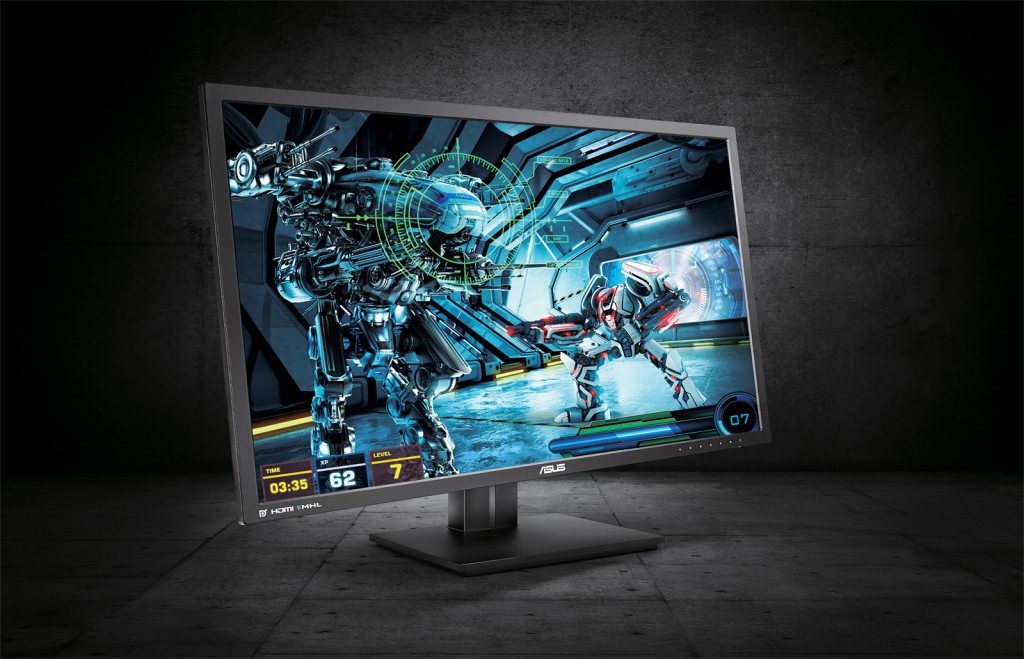Affordable ultra-high-definition displays are widespread on the market these days, just like high-quality and gaming monitors with 4K (3840*2160) resolution. Asustek Computer on Wednesday introduced its PB279Q monitor that combines quality, performance and relatively low price in one package.
The Asus PB279Q is based on a 10-bit in-plane switching (IPS) panel with wide color gamut of 100% sRGB and supports 3840*2160 resolution with 60Hz refresh rate (via DisplayPort inputs), which makes it perfect both for gamers who demand maximum refresh rate as well as multimedia fans and professionals who need accurate colours. The PB279Q display features 300cd/m² brightness, 100 000 000:1 dynamic contrast ratio as well as 5ms grey-to-grey response time. The display has 178°/178° viewing angles.
The PB279Q provides extensive connectivity options including DisplayPort 1.2 and mini DisplayPort, with support for 4K/UHD content at refresh rates of up to 60Hz. Additionally, there are four HDMI 1.4/MHL (mobile high-definition link) ports that allow users to view content stored on a mobile device on the PB279Q, while simultaneously charging the device.
Just like other higher-end monitors from Asustek, the PB279Q monitor supports a variety of the company’s technologies designed to improve user experience (Asus EyeCare, Asus SmartContrast, Asus VividPixel, etc.). The display has ergonomic stand that supports various positions and is also VESA mount-compatible, allowing it to be securely mounted on a wall or multi-monitor stand (just in case one 4K monitor is not enough).
Previously the combination of Asus PB279Q’s features – IPS panel, 4K resolution and 60Hz refresh rate – was available only on rather expensive models. However, the PB279Q will start at $799 (£510) when it becomes available from mid-December in Taiwan, Asia Pacific, and Europe.
Discuss on our Facebook page, HERE.
KitGuru Says: Given the feature-set and price, the Asus PB279Q will inevitably get multiple “must buy” awards from reviewers. While it does not support trendy features like Nvidia G-Sync or AMD FreeSync, it has all chances to become a monitor of choice for a lot of gamers too. It will also be interesting to see when other makers follow Asus with their announcements of similar products. Probably, we will have to wait till CES next month.
 KitGuru KitGuru.net – Tech News | Hardware News | Hardware Reviews | IOS | Mobile | Gaming | Graphics Cards
KitGuru KitGuru.net – Tech News | Hardware News | Hardware Reviews | IOS | Mobile | Gaming | Graphics Cards





ASUS is on fire! They seem to be the only company pushing the boundary into gaming-oriented monitors. Sadly due to IPS the response rate is probably pretty bad, but that’s a tradeoff we have to deal with.
well, im not a hardcore gamer, so i can surely trade off the super fast response rate with a good image and color quality.
I don’t consider myself “hardcore” anymore, but ghosting is a real problem I’ve run into whenever trying to use an IPS monitor. So to me it’s an issue of “any” gaming. Any time you have something that moves fast enough, you’ll have ghosting
the asus im using have the “trace free” setting. After i set it to 40%, ghosting seem to be gone. So i find myself a balance between IPS and ghost-free( well, not noticable) image, which is nice.
Oh nice! What model would that be? I might consider it. I have an older TN 120Hz panel right now, but it’s not only showing it’s age, the picture quality was never that good, particularly considering backlight bleed and color uniformity at angles. I’d go for one of those fancy 144Hz TN panels, but I like the uniformity and viewing angles of an IPS better, so I am kind of weighing my options.
not a bad launch price for 4k IPS i guess, but im looking forward to the day they are 200-250
It’s a 21:9 one, ASUS PB298Q.
I suspect this is the same panel used by Dell in P2715Q and Benq in BL2711U: the AU Optronic AHVA panel: M270QAN01.0/1/2
I’m looking forward to some Colorimeter measurements on this panel. sRGB is pointless these days, they all have 100% sRGB. How much of AdobeRGB it covers? how good is the uniformity? any IPS glow or gamut shift on 45 degrees viewing angles?
2025 ?